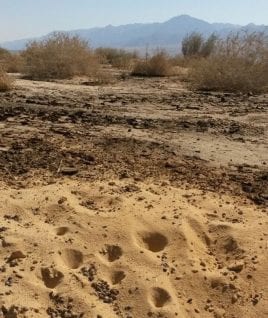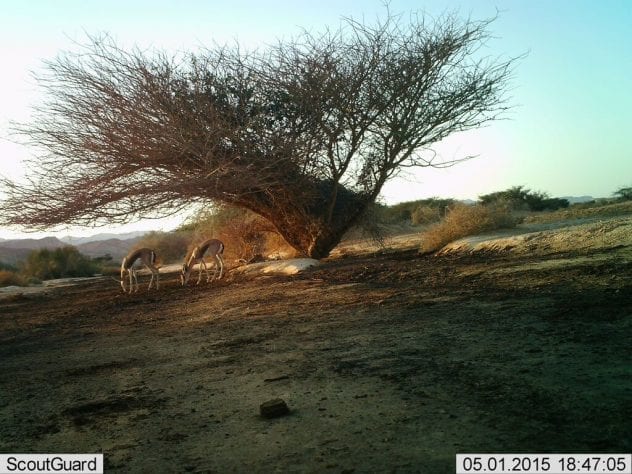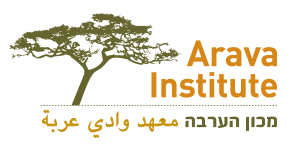
EVRONA NATURE RESERVE
In December 2014, an oil pipe burst near Be’er Ora causing an oil spill that spread to the Evrona Nature Reserve and contaminating approximately one million square meters of land in its wake (Figure 5). Tests have been ongoing since to analyze the impacts of the 2014 spill on ecosystem biodiversity, as well as predicting long-term effects by monitoring impacts from the 1975 oil spill in the same region. The Center monitors various parameters in the reserve including biodiversity of animals, plant physiology, soil fauna, soil characteristics and other aspects.

Soil Monitoring:
On a monthly basis, in both the location of the 1975 spill and the location of the 2014 spill, soil moisture, total organic carbon, and soil texture are monitored; soil in unaffected areas is also monitored as a control group.
No significant difference in species composition has been found between the contaminated areas and the control areas. For the 1975 oil spill, twelve soil samples were gathered from a control area, five samples from the north of the contaminated site, and five samples from south of the contaminated site. Monitoring in the 1975 oil spill site ended in May 2015.
To monitor the effects of the 2014 oil spill, both northern and southern sites were chosen to test contaminated soil versus control. In addition, to capture a salt gradient that was detected on the site, the control testing was chosen east and west of the oil spill. At both northern and southern sites, five samples were taken from the contaminated area, five from the east side, and another five from the west side.
The samples were then dried and weighed to calculate soil moisture, after which they were measured for organic carbon content (TOC). A hydrometer was used to measure soil texture, which provided information about water flow potential, water holding capacity, and fertility potential. Samples have been collected since February 2015 and monitoring continues on a monthly basis.
Mesofauna:
As in other sites, the Berlese funnels are being adapted in Ein Evrona to monitor mesofauna and understand the impact of seasonal differences and the presence of oil on mesofauna composition.
Acacia Monitoring in Ein Evrona:
Monitoring is being performed on samples of species Acacia tortillis and Acacia raddiana in Evrona using The Center’s standardized protocol. Normalized Difference Vegetation Index (NDVI) is being calculated monthly for 60 contaminated trees in the north of the Reserve (30 Acacia tortillis and 30 Acacia raddiana), 30 contaminated trees in the south of the Reserve, 30 trees in a control area east of the oil spill, 30 trees in a control area west of the oil spill, and 30 trees in a control area south of the Reserve. Parameters c, f, h, and l-n are calculated monthly for the aforementioned trees, and all other parameters are measured once a year. Tree size (height and canopy) was also measured in the region of the 1975 oil spill for 92 contaminated trees, 48 trees in a control area north of the oil spill, and 37 trees in a control area south of the oil spill.
Plant Community Composition:
Samples and data were collected in 2015 about plant species present in the area affected by the 1975 oil spill in order to identify the effect of oil pollution on perennial plant composition. Samples were taken from 44 total transects, of which 29 were located in the contaminated area; 15 were located in control areas, 7 north and 8 south of the polluted area.
Each plant individual rooted within the transect was identified in the field to the species level; the abundance of each species per transect was also counted. The total area sampled was 22,000 m2, and yielded samples of 2135 plant individuals belonging to 16 different species. In order to evaluate the residual impact of the oil spill on perennial plant community composition, the similarity between the contaminated area and the control was calculated using a Bray Curtis ß diversity index. As a reference for natural differences in the environment of the Reserve, the difference between both control areas was calculated identically. Constrained ordinations were performed using the program CONOCO5 to find the variability in species composition due to contamination by the oil spill. Redundancy analysis (RDA) was then applied using the location of the transect areas as environmental variables in order to quantify the variance in plant composition due to differences in the salt content of the soil. The difference in abundance of the seven most dominant species between the contaminated area and the control area was compared using a one-sided t-test for data with homogenic variances. Finally, the data was compared to an analysis of the plant species present in Wadi Shita.
Ant Lions:
The density of ant lion funnels in relation to areas with oil contamination from the 2014 spill in the Evrona Nature Reserve is being tested as a bio indicator for the health of soil macrofauna. They are an indicator of surrounding insect populations since ant lions are highly dependent on them for survival. A comparison of the funnel density in the path of the oil spill, adjacent to the oil, and in areas untouched by oil can be used to determine the effect of oil on the construction of ant lion funnels (Figure 6). A comparison of the density of funnels in the 2014 spill to the 1975 spill is also being performed to ascertain the long-term impact of oil spills on ant lion populations.

Animal Tracking:
Beginning on April 17, 2015, two motion-sensing cameras were installed near acacia trees in the Evrona Nature Reserve. Photographs were collected from both cameras and used to identify animal activity of gazelles, lizards, multiple bird species, foxes, wild dogs, and hares around the trees for approximately two weeks per month. Analysis determined the impact of the time of day and month on the activity of each species.

Nitzan Segev, Inbal Pipman, Rachamim Shemtov, Heidi Reinheimer, Nitzan Segev, Yanai Shlomi
“Ecological opinion on the oil contamination at the Evrona Nature Reserve”
Published: February 28, 2015
by Dr. Elli Groner, Dr. Idan Shapira, Nitzan Segev, and Elad Tofel
The report contains a review of relevant scientific literature as well as information obtained through consultations with Israeli experts in pertinent disciplines (soil microorganisms, desert plants, geology, etc.) regarding both the 2014 oil spill and the 1975 oil spill. Twenty-nine experts in taxonomic groups were interviewed and 140 articles were examined and quoted in the work. The report was accepted by the Israel Ministry of Environmental Protection.

